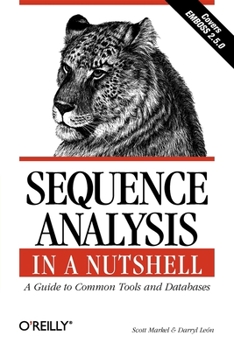Sequence Analysis in a Nutshell: A Guide to Tools: A Guide to Common Tools and Databases
Select Format
Select Condition 
Book Overview
Gene sequence data is the most abundant type of data available, and if you're interested in analyzing it, you'll find a wealth of computational methods and tools to help you. In fact, finding the data is not the challenge at all; rather it is dealing with the plethora of flat file formats used to process the sequence entries and trying to remember what their specific field codes mean. If you survive by surrounding yourself with well-thumbed hard copies of readme files or remembering exactly where to look for the details when you need them, then Sequence Analysis in a Nutshell: A Guide to Common Tools and Databases is for you. This book is a handy resource, as well as an invaluable reference, for anyone who needs to know about the practical aspects and mechanics of sequence analysis. Sequence Analysis in a Nutshell: A Guide to Common Tools and Databases pulls together all of the vital information about the most commonly used databases, analytical tools, and tables used in sequence analysis. The book is partitioned into three fundamental areas to help you maximize your use of the content. The first section, "Databases" contains examples of flatfiles from key databases (GenBank, EMBL, SWISS-PROT), the definitions of the codes or fields used in each database, and the sequence feature types/terms and qualifiers for the nucleotide and protein databases. The second section, "Tools" provides the command line syntax for popular applications such as ReadSeq, MEME/MAST, BLAST, ClustalW, and the EMBOSS suite of analytical tools. The third section, "Appendixes" concentrates on information essential to understanding the individual components that make up a biological sequence. The tables in this section include nucleotide and protein codes, genetic codes, as well as other relevant information. Written in O'Reilly's enormously popular, straightforward "Nutshell" format, this book draws together essential information for bioinformaticians in industry and academia, as well as for students. If sequence analysis is part of your daily life, you'll want this easy-to-use book on your desk.
Format:Paperback
Language:English
ISBN:059600494X
ISBN13:9780596004941
Release Date:March 2003
Publisher:O'Reilly Media
Length:302 Pages
Weight:0.95 lbs.
Dimensions:0.7" x 6.5" x 9.1"
Customer Reviews
2 ratings
from a bioinformatics student and programmer
Published by Thriftbooks.com User , 22 years ago
I picked this book up at BioCon 2003 and, to be honest, I wasn't sure at first how useful it was going to be. Flipping through a few of the sections, it seemed to be little more than an assemblage of man pages for each of the tools and programs it covered. So I put it on a shelf above my monitor at work for a while and as the days went by I found myself grabbing it more and more often to look something up. For example, I found myself needing reminding of the option for tabular output when doing a psi-blast. Grab the book ... a ha! ... -m 8. You can use the man pages or tutorials for many of things like this but sometimes there is a lot to wade through to find what you were looking for. Also, if you're like me you like the feel of a book sometimes and the ability to scrawl notes in the margins. It's just nice having all the options right there on the page.To be fair to the authors, I don't think that Chia-hsiu Tu was very accurate in his review by saying that "this books focus on EMBOSS only" (sic). EMBOSS coverage does make up about 58% of the book, but it is a suite of 150 useful programs. Unless you want only a sentence or two about each one you're going to have to use up a few pages. You get just enough info to learn about each and a quick guide to their usage. If you want to know more, there are links to their full documentation online.Some sections are stronger than others. The MEME/MAST chapter, for instance, doesn't just list out options but has great command line examples and a paragraph for each explaining what is going on. On the other hand, I wanted to use stretcher (in the EMBOSS package) and there was only a quick example (the syntax of which didn't work for me) and a listing of six options. I needed to find out how to make it work in a non-interactive way and write its output to STDOUT, neither of which were illustrated (-auto and -stdout, by the way).Ok, let's get to what this book covers. The first section goes really in depth to cover the data-exchange formats that we nerds find ourselves writing parsing scripts for all the time. (yes, yes, bioperl, biojava, etc. are great, but they aren't in this book. Hopefully one will cover them soon.) What I found most useful were the example files for each format (EMBL, DDBJ, Genbank, FASTA, SWISS-PROT, PFAM, & PROSITE) and the tables that were laid out for them. For example, there are nice little tables listing every feature (62 at my count) and feature qualifier (74!) that you can expect to find in a DDBJ/EMBL/Genbank file. And for each of those there is a little descripton of what they represent. Very nice.The second part of the book covers these specific tools: ReadSeq, the BLAST suite (7 progs), BLAT, CLUSTALW, HMMER (10 progs), MEME, MAST, and the EMBOSS suite (~150 progs). These sections are pretty decent and while you won't find much info on how the algorithms behind the programs work, you will have everything you need to run the programs and fine-tune their
an excellent rteference book
Published by Thriftbooks.com User , 22 years ago
This books focus on EMBOSS only, a high quality open source bioinformatic toolkit. It can be a useful reference book when write web interface of those programs in this book. Also it provides the urls where we can download from? where the original idea come from?






